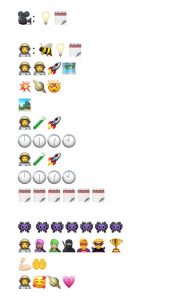
Communicating information using only emojis was an interesting task! I use emojis regularly when texting or at the end of the occasional e-mail but usually only to convey emotion (a happy face, mind blown, or thumbs up). I have never tried to use emojis for anything more than that. I changed my movie choice several times as things I thought would be easy quickly became quite difficult.
I began with the title as it is how I both learned to read and write; from the beginning. I relied on using the emojis to represent ideas more than the words themselves but there was some combination at the beginning. I quickly found, as Bolter (2001) points out, that picture writing lacks narrative power. The picture elements have a broad range of verbal meanings where each element means too much instead of too little (p. 59). The pictures have too many meanings and I struggled to find a way to point my audience in only one direction. I told the story with one idea per line from top to bottom, building on Kress’s (2005) discussion that knowledge through writing is set out in a specific manner; chapters are numbered and not to be read out of order because they build on each other (p. 7). My story needs to be interpreted from top to bottom to make sense. Kress (2005) continued to claim that meaning in language is clear and reliable while meaning in images is not solid or clear (p.8). I found this to be the case in my story. Using only images, the story I told is not clear and left open to a lot of interpretation. I found I did not have enough emojis to choose from. It would be interesting to write the same story using a hybrid of words and emojis. This would be a fun exercise to do with students and have them discuss what they notice the similarities and differences are in the storytelling experience!
References:
Bolter, J. D. (2001). Writing space: Computers, hypertext, and the remediation of print (2nd ed.). Mahwah, N.J: Lawrence Erlbaum Associates.
Kress (2005), Gains and losses: New forms of texts, knowledge, and learningLinks to an external site.. Computers and Composition, Vol. 2(1), 5-22.
Is your emoji story Lightyear? Very clearly depicted title!
Yes you got it!